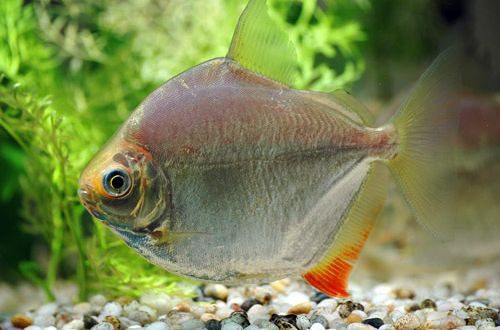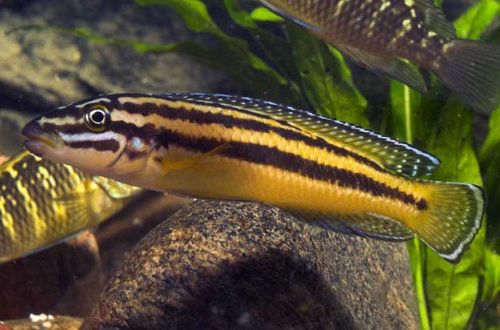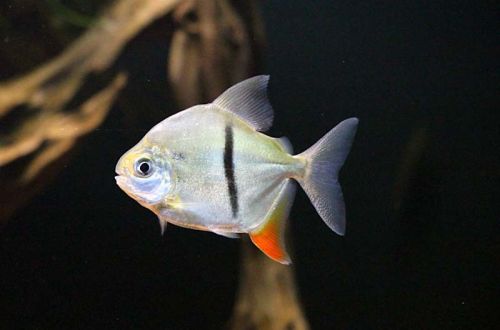
Cardinal
Cardinal, scientific name Tanichthys albonubes, belongs to the Cyprinidae family. The most popular aquarium fish, easy to keep and breed. As of 2010, there are four well-established breeding color forms, but only two of them are most widely used – close to natural color and with a predominance of red.
Contents
Habitat
The homeland of the species is the territory of modern China. Currently, fish are practically not found in the wild and are on the verge of extinction, listed in the Red Book. Several relict populations have been found in the coastal province of Guangdong (southern China) and in the province of Quang Ninh, northeast Vietnam. They live in slow-flowing rivers and streams, prefer to stay at shallow depths up to 60 cm near dense coastal aquatic vegetation.
Brief information:
- The volume of the aquarium – from 60 liters.
- Temperature – 14-22°C
- Value pH — 6.0–8.5
- Water hardness – soft to hard (5-21dGH)
- Substrate type – any
- Lighting – subdued
- Brackish water – no
- Water movement – weak current or still water
- The size of the fish is up to 4 cm.
- Food – any food
- Temperament – peaceful calm fish
- Keeping in a flock of 10 individuals
Description
Adults reach a length of 4 cm. Females are somewhat larger than males, but less colorful. There are several color forms. One is closer to natural coloration, the dominant color is gray with a wide bright pink stripe stretching from head to tail. The wide fins have a pale yellow edging. Another form has a similar color, but with a pronounced red pigment, which is painted on the back of the body, tail and edges of the fins.
Food
They accept all types of dry, frozen and live food. A combination of different species is the most preferred option, in this case the fish show their best color. Feed 2-3 times a day in the amount eaten in 5 minutes, remove leftovers in a timely manner to prevent water pollution.
Maintenance and care, arrangement of the aquarium
The recommended volume of the tank for one flock of fish starts from 60 liters. The design is arbitrary, however, a combination of a dark substrate and a certain amount of floating plants is considered the best option. Artificial or natural snags, roots and / or branches of trees are used as decor.
The standard set of equipment consists of filtration and lighting systems, an aerator. The cardinal prefers relatively low temperatures, so there is no need for a heater if the aquarium is set up in a living area.
Water conditions are characterized by a weak internal flow, temperature, pH and dGH parameters are in a wide acceptable range of values, so the preparation of water is not associated with great difficulties, in most cases it is enough to defend it during the day.
Aquarium maintenance consists in weekly replacement of part of the water (20–25% of the volume) with fresh water, regular cleaning of the substrate from organic waste and removal of plaque from the glass.
Behavior and Compatibility
Calm peace-loving fish, goes well with other species of similar size and temperament, able to live in similar temperature conditions. The content is flocking from 10 individuals of both sexes; within the group, males are forced to compete with each other for the attention of females, which contributes to an increase in the brightness of their color.
Breeding / breeding
Cardinal refers to spawning species, females scatter eggs in the water column, and males at this moment fertilize it. Parental instincts are poorly developed, immediately after spawning, the fish can eat their own caviar and fry that have appeared.
Breeding is recommended to be carried out in a separate tank – a spawning aquarium, in order to protect offspring from adult fish. The design is simple, the main attention is paid to the ground, it should consist of particles of a sufficiently large size that do not fit tightly to each other, forming voids, for example, pebbles or decorative glass beads. When the eggs sink to the bottom, most of them fall into these voids and thus become inaccessible to fish. A similar effect is also achieved when using a fine mesh, which is fixed at the bottom.
Another way to ensure the preservation of eggs is to use low-growing small-leaved plants or mosses such as Riccia floating and Javanese moss, which are planted on most of the surface of the substrate (in this case, the soil can be any). Dense thickets of plants can provide reliable shelter for eggs no worse than special soil.
The size of the spawning aquarium is usually 20-30 liters, half filled. The equipment used is an aerator, a heater and a simple sponge filter of low power to prevent accidental suction of eggs and fry. Spawning occurs in dim light, so at first there is no need for a light source.
The impetus for the beginning of the mating season is the establishment of a water temperature in the region of the upper permissible mark of 20–21 ° C at a neutral or slightly acidic pH value, as well as the inclusion of protein foods in the daily diet – bloodworms, daphnia, brine shrimp in live or frozen form.
After some time, the females become noticeably rounder, and the males will begin to actively show signs of attention to their chosen ones. At this point, you should prepare a separate tank and fill it with water from the general aquarium, then transplant several females and the most colorful males there. The easiest way to determine the end of spawning is by females, they will become slender.
The fish are returned. The fry will appear in 48 – 60 hours, and in another day they will begin to swim freely. Feed with specialized microscopic food for feeding juvenile aquarium fish.
Fish diseases
Due to long-term hybridization and inbreeding, undesirable consequences appeared in the form of weak immunity and a high proportion of congenital malformations among juveniles. A balanced diet and suitable living conditions reduce the risk of disease, but do not eliminate them. Read more about symptoms and treatments in the Aquarium Fish Diseases section.





